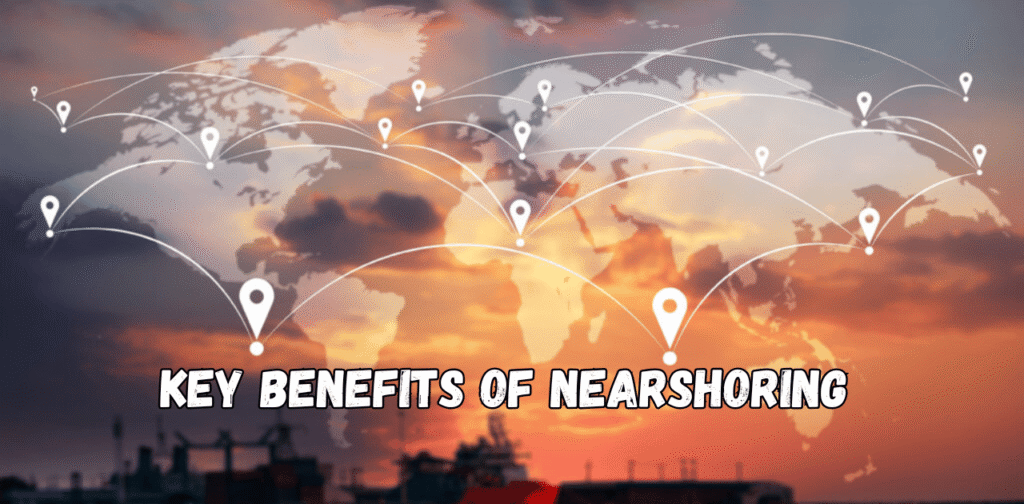Supply chain disruptions, run-away costs, and geopolitical tensions have forced enterprises to rethink their approaches to manufacturing and sourcing. One of the terminologies that has gained momentum over time is nearshoring. But really, what is nearshoring in reality and why do many businesses try it out?
What is Nearshoring?
Nearshoring is a business perspective in which part or all manufacturing or service business operations are transferred to a neighbouring country; normally one that is on adjacent borders or within the same geographical zone.
Close to home, in production, efficiency, cost-saving, and added control of the supply chain would be the objectives of nearshoring. Therefore, it stands in direct contrast to offshoring, whereby companies, from far and cheap countries (U.S.-based firms outsourcing to China, for instance), are moving operations abroad; nearshoring puts a larger priority on the proximity rather than on pricing.
Key Benefits of Nearshoring

1. Quicker Delivery Times
Since they’re in geographical proximity, short shipping distances are paramount, and delivery in no time-everything a customer demands.
2. Cost Saving
Labor costs may not be as low as that of off-shore locations, but on saving on logistical costs, tariffs, and inventory-carrying costs, companies save a lot.
3. Better Communication
With time zones on the same page, cultural similarity can often smooth collaboration in particular service industries such as IT and customer support.
4. Supply Chain Resilience
Bringing supply chains closer allows firms to reduce dependence on long and complex global supply chains that are prone to disruption from pandemics and political tensions to port congestion.
5. Green House Strategy
Reduction of transport distances entails reduction of carbon footprint, thus contributing to the sustainable development agenda and green logistics strategy.
Nearshoring Examples
- One instance would be an American company moving its manufacturing from Asia to Mexico.
- Another would include an automobile company relocating its production from China to Eastern Europe.
- Also, a Canadian tech company has been outsourcing IT work to Latin America as opposed to India.
- Offshoring work to another country is simply the definition. Somewhere away means offshore. Offshoring is basically not so bad. It is that low-cost service offered by foreign countries-miles away-that engages labor at lower costs.
- Nearshoring: The countries next to or bordering your home country.
- Nearshoring provides: A schematic cost high enough to balance a little with distance
- Onshoring: Domestic in Ontario, Maximum control and speed
Industries nearshoring in IT, software development, customer support, and call centers, pharmaceuticals, and medical devices. Challenges facing nearshoring: Companies could still face challenges, amongst them limited skilled labor in some bordering areas. Poor infrastructure or political instability. The initial transition cost and capital.
Conclusion
Cost Speed Control Nearshoring is a strategic move to reduce costs while keeping a balance on speed and control. Since companies want to create a more flexible and resilient supply chain, nearshoring could be an alternative to the traditional offshore route. Whether it is manufacturing or any activity on the tech or logistics side, it is worth considering this trend for future growth and sustainability.
FAQ about Nearshoring
Q1: Why is near-shore outsourcing becoming the norm nowadays?
A1: The risks of a long-distance supply chain have become glaring in view of events occurring in the world: COVID-19, trade wars, rising transportation costs, thus making near-shore more attractive.
Q2: Is it only applicable to the big guys?
A2: No. It has small and medium enterprises as applicable too. Nearshoring applies to any kind of business, especially in IT and service outsourcing or specialized manufacturing.
Q3: Which countries are the top near-shoring destinations for U.S. and European companies?
For near-shoring, the top candidates to be considered by U.S. companies are Mexico, Costa Rica, and Colombia. Considering Polish, Czech, and Romanian would be the first ones on the list for all European companies.
Q4: What is Nearshoring versus Reshoring?
Reshoring refers to bringing back the production or manufacturing to the home country of a firm; nearshoring is moving that production or manufacturing to a comparatively nearby foreign country.
Q5: What role does technology play in nearshoring?
Nearshoring would use advanced digital tools: supply chain management software, automation, and real-time tracking to track the fulfilled operations improvement, and the effectiveness and visibility of scope.



